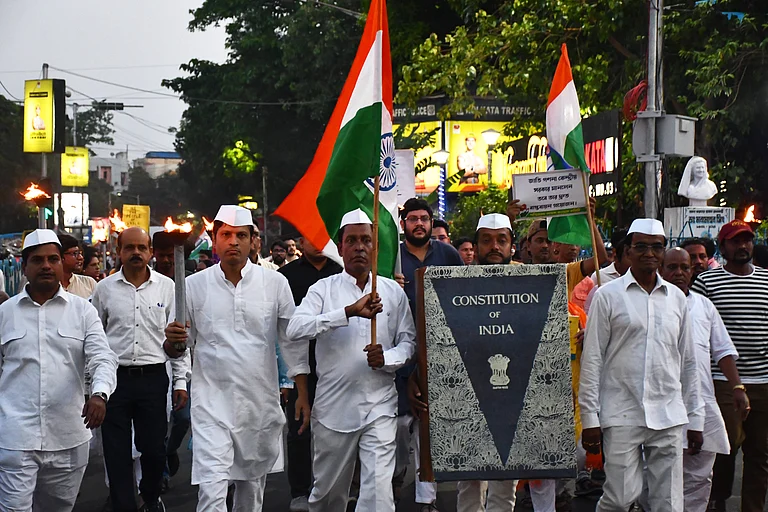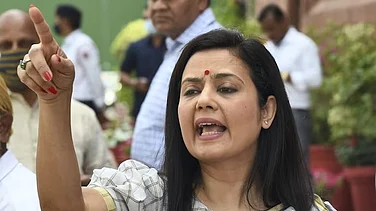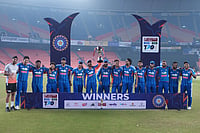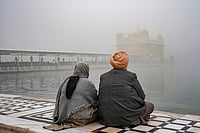
From the outset, the Rashtra Sevika Samiti was not constituted as a wing of the RSS.
It was autonomous, reflecting both the gendered boundaries of the Sangh and the acknowledgement that women required platforms of their own.
This autonomy generated a paradox that endures to this day.
As the Rashtriya Swayamsevak Sangh (RSS) turns 100 in 2025, questions about women’s place within its ideological and organisational universe acquire fresh urgency. From its very inception in 1925 under the leadership of K.B. Hedgewar, the RSS was conceptualised as a fraternity of men. Its daily shakhas revolved around martial drills, physical discipline and camaraderie. It was an idiom tailored for male bonding and brotherhood.
Women, by contrast, were located in the private domain of the household. Their role was to transmit cultural values within the family rather than participate in the collective drill, instruction and ideological training that defined the Sangh.
Yet by the mid-1930s, the limitations of this exclusion became visible and it led to the emergence of a parallel structure which would reshape Sangh’s relationship with women for the next century.
The Rashtra Sevika Samiti, founded in 1936 by Laxmibai Kelkar, was the most important institutional response to this gap. Often described as the “women’s RSS”, the Samiti adapted the shakha model for female participation. Its members wore uniforms, practiced drills and underwent ideological training. But their participation was grounded in the ideal of stridharma—the dharma of women—understood not as rights or individual autonomy but as duty, service and sacrifice to family, society and nation. The voices of women within the Samiti shed light on how they interpret their roles.
The Rashtra Sevika Samiti founder was explicit about the civilisational significance of women’s awakening. “Woman is the inspiring force for the family and for the nation. So long as this force is not awakened, society cannot progress,” she declared. Her words emphasised not individual rights but collective uplift through the spiritual and moral force of women. During the Partition, when women in Karachi faced displacement and violence, Kelkar exhorted them: “Have patience and protect your modesty. Trust the organisation and continue serving your motherland. This is the time of test for us.” Such exhortations capture the idiom of sacrifice and duty that became the moral compass of the Samiti.
The current Samiti chief, V. Shantha Kumari (Shanthakka), reinforces this ethos in contemporary terms. She insists that the organisation seeks to make women “strong physically, mentally and intellectually” so that they can act as guides for both family and nation. Here again, the emphasis is not on rights but on resilience, strength and service. Women are trained not for autonomy but for duty, not for self-assertion but for collective uplift.
From the outset, the Samiti was not constituted as a wing of the RSS. It was autonomous, reflecting both the gendered boundaries of the Sangh and the acknowledgement that women required platforms of their own. This autonomy generated a paradox that endures to this day: women were formally absent from the RSS itself, yet deeply embedded in its wider ecosystem. They were indispensable to the movement’s vitality but remained outside its ideological core.
RSS ideologues have long sought to resolve this paradox by invoking the Scouts and Guides analogy. Just as Scouts and Guides are parallel and complementary organisations rather than unequal ones, swayamsevaks and sevikas are framed as two streams of the same national project. In this telling, the question of exclusion is unfounded. There is no inequality, only differentiated inclusion. Women and men contribute in distinct yet complementary ways.
However, critics argue that the analogy obscures fundamental asymmetries. The RSS remains the ideological nucleus of the Sangh Parivar, defining doctrine, strategy and direction. The Samiti, despite its autonomy, is peripheral to this centre. Women may lead, mobilise and train, but they cannot enter the RSS itself. The division is therefore not merely parallel but hierarchical: one organisation establishes the ideological line; the other reproduces and disseminates it.
However, the diaspora experience complicates this further. In the United States, the United Kingdom and parts of Africa, shakhas are often family-centric. Women and children participating alongside men. Here, gender segregation dissolves in practice because the survival of the organisation abroad depends on full family involvement. If integration is both possible and functional abroad, why is separation so rigidly preserved at home?
Interestingly, within these frames, women have carved out genuine spheres of authority. Today, women occupy roughly 20 per cent of leadership positions across the Sangh ecosystem, a proportion that surpasses their representation in the Indian Parliament. They exercise authority through the Rashtra Sevika Samiti, the Akhil Bharatiya Vidyarthi Parishad, the Durga Vahini, and newer initiatives like Bharat Stree Shakti. They direct mobilisation strategies, shape ideological training and provide moral authority in moments of crisis. Their activism during the Ram Janmabhoomi movement offers a striking example. Women were not passive supporters but active protestors and organisers. However, their participation was consistently narrated in the language of service and sacrifice and not autonomy and rights.
The question then arises—what are these women shaping, why are they there, and what challenges do they face from within? Women shape the Sangh’s cultural legitimacy, its mass base, and its grassroots reach. They are present because the Sangh requires their moral authority, their ability to mobilise households, and their role as intergenerational transmitters of ideology. They face challenges because their empowerment remains ideologically circumscribed. They can lead in the ecosystem but not in the core; they can embody Shakti but remain outside the sanctum.
Despite these constraints, examples of genuine leadership opportunities abound. Uma Bharti, nurtured within the Sangh world, rose to become Chief Minister of Madhya Pradesh and a Union Minister. Nirmala Sitharaman, long associated with Sangh networks, is now India’s Finance Minister. Within the Samiti, figures like Pratibha tai Apte shaped ideological training for decades, influencing generations of women volunteers. These are not token roles but positions of real authority. They demonstrate that the Sangh has created a distinctive pathway to women’s leadership—one that exists outside the RSS core but is nevertheless consequential.
Placed in comparative perspective, this achievement is notable. The CPI(M), despite producing leaders such as Brinda Karat, remains a male-dominated party at its highest levels. The Congress, despite the towering legacy of Indira Gandhi, has not institutionalised women’s leadership in its structures. Trade unions and farmer movements have mobilised vast numbers of women but rarely sustained them in positions of authority. Against this backdrop, the Sangh’s ability to maintain nearly one-fifth women in leadership roles is both an internal strength and an indictment of the wider failures of Indian political culture.
The story of women in the Sangh is, therefore, not one of simple exclusion. It is the story of a paradox—of autonomy granted and centrality denied, of empowerment defined through duty, of leadership achieved outside the core but never within it. As the RSS steps into its second century, the question can no longer be deferred. If women already constitute one-fifth of the leadership across the Parivar, if they have carried the weight of mobilisation in moments of ideological crisis, if they are indispensable for sustaining the organisation abroad, then can their absence from the RSS itself endure indefinitely? What would it mean—for the Sangh, for Indian politics and for Indian society—if the next century were to witness not only women in the ecosystem but women at the very heart of the RSS?
(Views expressed are personal)
Shubhrastha is a writer, poet, and political strategist
























